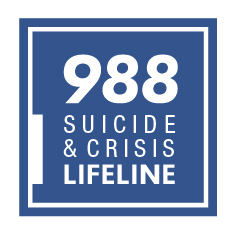Help Prevent Suicide
988 Suicide & Crisis Lifeline
If you are feeling alone and having thoughts of suicide—whether or not you are in crisis—or know someone who is, don’t remain silent. Talk to someone you can trust through the 988 Suicide & Crisis Lifeline. Call or text 988 or chat the Lifeline.
-
Help for You
Talking with someone about your thoughts and feelings can save your life. There are steps you can take to keep yourself safe through a crisis. Call or text 988 any time or chat online with the 988 Suicide & Crisis Lifeline to get support also find resources on:
- Finding a therapist/support group.
- Building and using a support network.
- Making a safety plan for yourself
Help for Someone You Know
Learn how to recognize the warning signs when someone’s at risk—and what action steps you can take. If you believe someone may be in danger of suicide:
- Call or text 988 to reach the 988 Suicide & Crisis Lifeline to talk to a caring professional.
- Ask them if they are thinking about killing themselves. This will not put the idea into their head or make it more likely that they will attempt suicide.
- Listen without judging and show you care.
- Stay with the person or make sure the person is in a private, secure place with another caring person until you can get further help.
- Remove any objects that could be used in a suicide attempt.
-

Who Is at Risk?
Thoughts of suicide can touch any person anywhere. But some groups in the U.S. are more at risk for various reasons. Learn more about how to help these groups and special resources available.
-
Warning Signs
The causes of suicide are complex and determined by multiple combinations of factors, such as mental illness, substance abuse, painful losses, exposure to violence, and social isolation.
Warning signs that may mean someone is at risk include:
- Talking about wanting to die or kill oneself
- Looking for a way to kill oneself
- Talking about being a burden to others
- Increasing the use of alcohol or drugs
- Acting anxious or agitated; behaving recklessly
- Sleeping too little or too much
- Withdrawing or feeling isolated
- Showing rage or talking about seeking revenge
- Displaying extreme mood swings
-
About the 988 Suicide & Crisis Lifeline
The 988 Suicide & Crisis Lifeline is a free, confidential 24/7 phone line that connects individuals in crisis with trained counselors across the United States.
You don’t have to be suicidal or in crisis to call the Lifeline. People call to talk about lots of things: substance abuse, economic worries, relationships, sexual identity, illness, getting over abuse, depression mental and physical illness, and loneliness. Here’s more about the 988 Suicide & Crisis Lifeline:
- You are not alone in reaching out. In 2018, more than 2.2 million people called the Lifeline.
- The Lifeline is funded and managed by SAMHSA. The Lifeline is a network of over 150 crisis centers nationwide.
- Calls to the Lifeline are routed to the nearest crisis center for connections to local resources for help.
- Responders are trained counselors who have stopped over 90 percent of suicide attempts or ideation among callers.
- Learn what happens when you call the Lifeline network.
- Frequently asked questions about the Lifeline.
What We Know About Suicide in the U.S.
Someone dies from suicide every 11 minutes — and for the first time in recent generations, life expectancy is decreasing due to suicide. According to the latest research:
- There were 1.2 million attempts and more than 46,000 deaths from suicide.
- Suicide is at its highest level and is still rising.
- Rural counties are being hit the hardest with suicide rates double the rate in urban counties.
Suicide touches whole communities. Each person who dies by suicide leaves behind people who knew that person, along with the impact of suicide and the bereavement that follows.
Everyone has a role to play in preventing suicide. For instance, faith communities can work to prevent suicide simply by helping people navigate the struggles of life to find a sustainable sense of hope, meaning, and purpose.
Losing a loved one to suicide can be profoundly painful for family and friends. SAMHSA’s Suicide Prevention Resource Center helps loss survivors find local and national organizations, websites, and other resources that provide support, healing, and a sense of community.
-

988 Suicide Prevention
Help for those strengthening their suicide prevention and mental health crisis services.
-

Suicide Prevention Resource Center
Designed to provide resources, programs, and trainings to those involved in suicide prevention.
-

SAMHSA National Helpline
A free treatment referral and information service for individuals and families facing mental and/or substance use disorders.
-

Behavioral Health Treatment Services Locator
A confidential and anonymous source of information for persons seeking treatment facilities
-
SAMHSA Publications
- Helping Your Loved One Who is Suicidal: A Guide for Family and Friends
- Advisory: Addressing Suicidal Thoughts and Behaviors in Substance Use Treatment
- Prevention and Treatment of Anxiety, Depression, and Suicidal Thoughts and Behaviors Among College Students
- Treatment for Suicidal Ideation, Self-harm, and Suicide Attempts Among Youth
- After an Attempt: A Guide for Taking Care of Your Family Member After Treatment in the Emergency Department
- Stories of Hope and Recovery: A Video Guide for Suicide Attempt Survivors
- Suicide Prevention Publications
- Suicide Safe Mobile App
Federal Resources
- Suicide and Self-Harm FastStats | CDC
- Suicide: Additional Resources | CDC
- Suicide Rising Across America | CDC
- Preventing Suicide: A Technical Package of Policy, Programs, and Practices | CDC (PDF | 6.3 MB)
- Suicide in America: Frequently Asked Questions | National Institute of Mental Health (NIMH)
Other Resources

